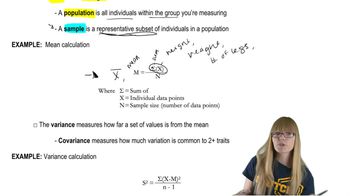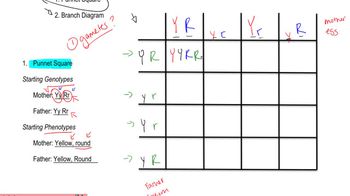Table of contents
- 1. Introduction to Genetics51m
- 2. Mendel's Laws of Inheritance3h 37m
- 3. Extensions to Mendelian Inheritance2h 41m
- 4. Genetic Mapping and Linkage2h 28m
- 5. Genetics of Bacteria and Viruses1h 21m
- 6. Chromosomal Variation1h 48m
- 7. DNA and Chromosome Structure56m
- 8. DNA Replication1h 10m
- 9. Mitosis and Meiosis1h 34m
- 10. Transcription1h 0m
- 11. Translation58m
- 12. Gene Regulation in Prokaryotes1h 19m
- 13. Gene Regulation in Eukaryotes44m
- 14. Genetic Control of Development44m
- 15. Genomes and Genomics1h 50m
- 16. Transposable Elements47m
- 17. Mutation, Repair, and Recombination1h 6m
- 18. Molecular Genetic Tools19m
- 19. Cancer Genetics29m
- 20. Quantitative Genetics1h 26m
- 21. Population Genetics50m
- 22. Evolutionary Genetics29m
20. Quantitative Genetics
Analyzing Trait Variance
Problem 31
Textbook Question
A total of 20 men and 20 women volunteer to participate in a statistics project. The height and weight of each subject are given in the table.Compare the numerical values with the visual distribution of heights and weights you drew in the histograms and describe whether you think your visual impression matches the numerical values.
 Verified step by step guidance
Verified step by step guidance1
Step 1: Begin by organizing the numerical data for heights and weights of the 20 men and 20 women into two separate datasets. Ensure the data is clearly labeled by gender and variable (height or weight).
Step 2: Calculate summary statistics for each dataset, including measures such as mean, median, mode, range, and standard deviation. Use these values to understand the central tendency and spread of the data.
Step 3: Create histograms for each dataset (heights and weights for men and women). Ensure the histograms have appropriate bin sizes and are labeled clearly to visually represent the distribution of the data.
Step 4: Compare the visual distribution in the histograms to the calculated numerical values. Look for patterns such as symmetry, skewness, or clustering in the histograms and see if they align with the summary statistics (e.g., mean and median).
Step 5: Write a description comparing the visual impression from the histograms with the numerical values. Discuss whether the visual representation supports the numerical analysis or if there are discrepancies, and provide possible reasons for any differences observed.
 Verified video answer for a similar problem:
Verified video answer for a similar problem:This video solution was recommended by our tutors as helpful for the problem above
Video duration:
1mPlay a video:
Was this helpful?
Key Concepts
Here are the essential concepts you must grasp in order to answer the question correctly.
Descriptive Statistics
Descriptive statistics summarize and describe the main features of a dataset. This includes measures such as mean, median, mode, and standard deviation, which provide insights into the central tendency and variability of the data. Understanding these statistics is crucial for interpreting numerical values in relation to visual representations like histograms.
Recommended video:
Guided course

Descriptive Genetics
Histograms
A histogram is a graphical representation of the distribution of numerical data, where the data is divided into bins or intervals. Each bin's height reflects the frequency of data points within that range. Analyzing histograms helps in visualizing patterns, trends, and outliers in the data, allowing for a comparison with numerical statistics.
Recommended video:
Guided course

Mathematical Measurements
Correlation Between Visual and Numerical Data
The correlation between visual and numerical data involves assessing whether the graphical representation (like histograms) aligns with the calculated statistics. This comparison helps in validating the accuracy of the visual impression and understanding the underlying data distribution. Recognizing discrepancies can lead to deeper insights into the dataset's characteristics.
Recommended video:
Guided course

Punnet Square

 8:34m
8:34mWatch next
Master Analyzing Trait Variance with a bite sized video explanation from Kylia
Start learningRelated Videos
Related Practice
Textbook Question
Suppose the mature height of a plant is a multifactorial trait under the control of five independently assorting genes, designated A, B, C, D, and E, and five environmental factors. There are two alleles of each gene (A₁, A₂, etc.). Each allele with a subscript 1 (i.e., A₁) contributes 5 cm to potential plant height, and each allele with a 2 subscript (i.e., A₂, etc.) contributes 10 cm to potential plant height. In other words, a genotype containing only 1 alleles (A₁A₁B₁B₁C₁C₁D₁D₁E₁E₁) would have a potential height of [(10)(5)]=50cm, and a genotype with only 2 alleles (A₂A₂B₂B₂C₂C₂D₂D₂E₂E₂) would have a potential height of [(10)(10)]=100cm.The five environmental factors are (1) amount of water, (2) amount of sunlight, (3) soil drainage, (4) nutrient content of soil, and (5) temperature. Each environmental factor can vary from optimal to poor. If all factors are optimal, assume that full potential height is attained. However, if one or more of the environmental factors is less than optimal, then height is reduced. The state of each environmental factor has an effect on growth. In this exercise, we'll assume that the growth is affected according to the following scale:Environmental Factor State Height LostOptimal (O) 0 cmGood (G) 4 cmFair (F) 8 cmMarginal (M) 12 cmPoor (P) 16 cmThus, for example, if one environmental factor is optimal, two are good, one is fair, and one is marginal, the loss of potential height is . If the loss of height potential is greater than the height potential of the plant, the plant does not survive.List two genotypes that have a height potential of 80 cm.
387
views
